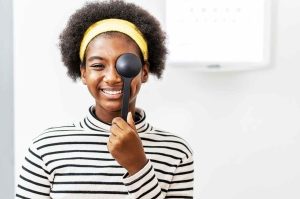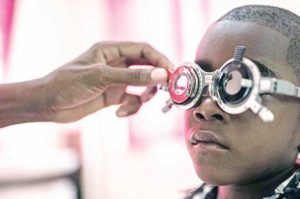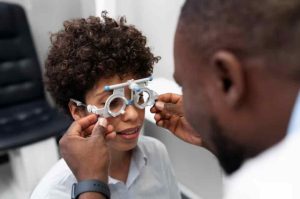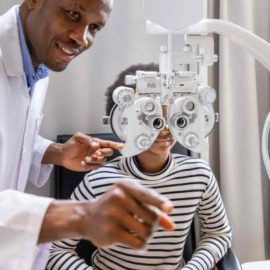Are Contact Lenses a Safe Vision Correction Option for Nigerian Kids?
In today’s world, where visual acuity plays a crucial role in academic success, social interactions, and overall well-being, the question of whether contact lenses are a safe vision correction option for Nigerian kids becomes increasingly significant. Contact lenses offer a convenient and often more aesthetically pleasing alternative to traditional eyeglasses. However, when it comes to children, ensuring their safety and comfort is paramount. This article aims to explore the safety aspects of contact lens usage specifically tailored to the needs and concerns of Nigerian children and their families.

Prevalence of Vision Problems in Nigerian Kids
Before delving into the safety considerations of contact lenses, it’s essential to understand the prevalence of vision problems among Nigerian children. According to recent statistics, a significant portion of Nigerian youth suffers from various vision impairments, ranging from refractive errors to more severe conditions such as amblyopia and strabismus. Left untreated, these issues can profoundly impact a child’s educational attainment, social integration, and future opportunities.
Understanding Contact Lenses
Contact lenses come in various types, including soft lenses, rigid gas permeable lenses, and specialized lenses for specific eye conditions. Unlike eyeglasses, which sit in front of the eyes, contact lenses rest directly on the cornea, providing a wider field of vision and eliminating visual distortions caused by lens frames. While contact lenses offer undeniable advantages in terms of comfort and aesthetics, they also pose unique challenges and risks, especially for younger wearers.

Safety Concerns with Contact Lenses
One of the primary concerns surrounding contact lens use, particularly among children, is the risk of eye infections and other complications arising from improper hygiene and handling. Failure to adhere to strict cleanliness protocols when inserting, removing, and storing contact lenses can lead to bacterial contamination, corneal abrasions, and potentially sight-threatening conditions such as microbial keratitis. Moreover, extended wear or overnight use of contact lenses without adequate rest periods increases the likelihood of oxygen deprivation and corneal hypoxia, further compromising ocular health.
Special Considerations for Children
Children’s eyes undergo continuous growth and development, making them more susceptible to changes in corneal curvature and lens fit. Unlike adults, who have relatively stable ocular dimensions, children’s eyes may exhibit greater variability in size and shape, necessitating regular reassessment of contact lens prescriptions and fittings. Additionally, children may lack the manual dexterity and maturity required to handle contact lenses responsibly, increasing the risk of accidental damage or misplacement.
Benefits of Contact Lenses for Kids
Despite these challenges, contact lenses offer numerous benefits for children, both in terms of visual correction and overall quality of life. For many young wearers, contact lenses provide a sense of independence and confidence, freeing them from the perceived stigma associated with wearing glasses. Contact lenses also offer practical advantages for active children involved in sports or recreational activities, eliminating the inconvenience of fogging lenses, slipping frames, or restricted peripheral vision.

Tips for Safe Contact Lens Use
To minimize the risk of complications and ensure the safe and effective use of contact lenses, parents and children should adhere to strict hygiene practices and follow the guidance of their eye care professionals. This includes thorough handwashing before handling lenses, using recommended cleaning solutions and storage cases, and adhering to prescribed wearing schedules. Regular eye examinations are essential for monitoring ocular health and detecting any signs of irritation or infection early on.
Regulatory Framework for Contact Lens Safety
In Nigeria, as in many other countries, contact lenses are regulated medical devices subject to stringent quality standards and safety regulations. Regulatory bodies such as the National Agency for Food and Drug Administration and Control (NAFDAC) oversee the importation, manufacturing, and distribution of contact lenses to ensure compliance with established guidelines. Consumers are encouraged to purchase contact lenses from licensed practitioners and reputable suppliers to guarantee product authenticity and safety.

Case Studies and Success Stories
Numerous success stories attest to the transformative impact of contact lenses on the lives of Nigerian children with vision impairments. From academic achievements to athletic pursuits, contact lenses have empowered young wearers to pursue their passions with newfound confidence and clarity. By sharing these inspiring narratives, we can raise awareness of the positive outcomes achievable through responsible contact lens use and encourage others to explore this vision correction option.
Common Misconceptions About Contact Lenses
Despite their proven safety and efficacy, contact lenses are often shrouded in misconceptions and myths, particularly among parents and caregivers. Addressing these misconceptions head-on is essential for dispelling fears and fostering informed decision-making regarding vision correction options for children. By providing accurate information and guidance, eye care professionals can help alleviate concerns about discomfort, hygiene, and age-appropriate wear.
Cost Considerations and Accessibility
While contact lenses may offer significant advantages over eyeglasses, cost and accessibility remain significant barriers for many Nigerian families. Unlike prescription glasses, which can be obtained relatively inexpensively, contact lenses require ongoing purchases of lenses, solutions, and accessories, placing a financial burden on households already struggling to meet basic needs. Government initiatives and charitable organizations play a crucial role in improving access to affordable vision care services for underserved populations.

Educational Campaigns and Awareness Programs
Raising awareness about the importance of eye health and vision care is essential for promoting early detection and intervention of vision problems in children. Educational campaigns targeting parents, teachers, and healthcare providers can help increase understanding of the benefits and risks associated with contact lens use and encourage proactive measures to safeguard ocular health. By partnering with schools, community centers, and religious institutions, we can reach a broader audience and address disparities in access to vision care services.
Future Trends and Innovations
Looking ahead, advancements in contact lens technology hold promise for further enhancing safety, comfort, and visual outcomes for children with vision impairments. From customizable lens designs to smart contact lenses capable of monitoring ocular health in real time, ongoing research and innovation are poised to revolutionize the field of pediatric optometry. Telemedicine platforms offer new opportunities for remote consultations and follow-up care, particularly in rural and underserved areas where access to specialized eye care services may be limited.
Conclusion
Contact lenses can be a safe and effective vision correction option for Nigerian children, provided that proper hygiene practices, regular monitoring, and professional guidance are observed. While contact lenses offer undeniable benefits in terms of comfort, aesthetics, and lifestyle flexibility, they also require a commitment to responsible use and ongoing care. By addressing safety concerns, dispelling myths, and advocating for greater access to affordable vision care services, we can ensure that every Nigerian child has the opportunity to see the world clearly and confidently.

